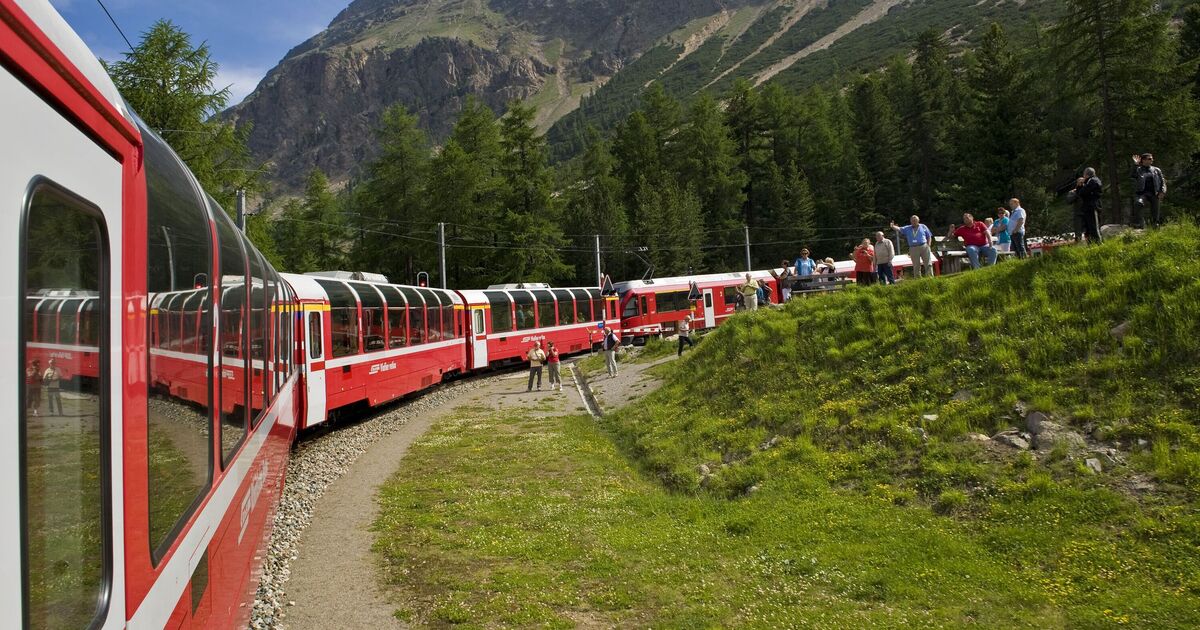
The Bernina Express passes through glaciers, gorges and down to palm trees (Image: Getty)
The Bernina Express, one of the globe’s most renowned scenic trains, covers 89 miles across the stunning landscapes of Switzerland and Italy.
As it journeys through 55 tunnels and over 196 bridges, passengers are treated to awe-inspiring views from specially adapted coaches, ranging from icy glaciers to tropical palm trees.
The entire trip spans approximately four to four and a half hours, a relatively brief journey compared to its sister train, the Glacier Express. The latter takes eight hours to travel from Zermatt to Saint Moritz, both located in Switzerland.
The Bernina Express embarks from Chur, Switzerland’s oldest town, and concludes its journey in Tirano, a charming town and commune in northern Italy.
En route, it traverses the UNESCO World Heritage Site of the Rhaetian Railway, recognised since July 2008 for its unique construction technology and routing.
Among the highlights of the journey are the majestic Bernina mountain range, the Morteratsch Glacier – the third largest glacier in the Eastern Alps, the trio of lakes Lej Pitschen, Lej Nair and Lago Bianco, the Alp Grum and the Brusio Circular Viaduct.
For those wishing to extend their adventure, the Bernina Express Bus offers a further 56-mile journey to Lugano, taking roughly three hours. This leg of the trip winds through Valtellina vineyards and picturesque villages along Lake Como.

This incredible 89-mile train ride links the two sides of the European continent (Image: Getty)
From Lugano, travellers can then speed through the Gotthard Base Tunnel back to German-speaking Switzerland.
The track is among the highest railway routes in Europe and holds the title for the world’s steepest. Departing from the city of Chur (585m) in Graubunden on the Albula line, the train traces the path of the Rhine to Bonaduz (655m).
It then ventures into the Domleschg Valley, following the Posterior Rhine from Rhazuns (658m) to Thusis (697m), before continuing towards Tiefencastel (851m). Here, it follows the Albula, crossing the Landwasser Viaduct before reaching Filisur (1,032m).
The journey continues through its first spiral tunnel to Bergun/ Bravuogn (1,373m).
Between Bergun/ Bravuogn and Peda (1,789m), at the valley’s end, the train must overcome a height difference of approximately 400m over a horizontal distance of 3.1 miles. This feat is achieved without the use of rack-and-pinion but with numerous spirals.
The train then enters the Alula Tunnel at 1,815m beneath the Albula Pass, emerging in Val Bever and proceeding to Bever (1,708m) on the Engadin plain. From there, it continues towards Samedan (1,721m), finally arriving at Pontresina station (1,774m) in Val Bernina.
On the Bernina line, the train departs Pontresina and gradually ascends through the valley to the Bernina Pass via Morteratsch station (1,896m). Here, passengers can glimpse the glacier and the Eastern Alps’ highest peak, Piz Bernina (4,093m).

The ride finishes or starts in Tirano, Italy, home to palm trees. (Image: Getty)
A stop at Bernina Diavolezza (2,093m) allows for a cable-car connection to Diavolezza. The Bernina Express reaches its zenith at the Ospizio Bernina station, situated 2,253m above Lago Bianco.
Alp Grum, situated at an elevation of 2,091m, is the first station south of the Alps, perched above Lago Palu and just beneath Piz Palu and its glacier. After navigating numerous hairpin bends, it ascends to Cavaglia (1,693m), overlooking Val Poschiavo, before reaching the Swiss-Italian-speaking town of Poschiavo (1,014m).
The route then traces the course of Poschiavo, making stops at Le Prese (964m) and Miralago (965m), both nestled on the banks of Lake Poschiavo. It continues its descent towards Brusio (780m), where it crosses the spiral Brusio Viaduct.
Shortly after crossing the Italian border at Campocologno (553m), the train concludes its journey at Tirano station (430m).
During the summer months, a special service operates from Chur to Pontresina with minimal stops. After switching locomotives in Pontresina due to a different electricity line on the Bernina line, the train proceeds with a few stops en route to Tirano. In other seasons, the train consists of several carriages that are attached to regional services.
The Rhaetian Railway company operates this service exclusively for sightseeing purposes. The coaches have been modified to offer panoramic views, featuring enlarged windows and multilingual audio guides available in English, German and Italian.
Although there’s no dining carriage, a minibar is available offering snacks and beverages. Passengers can enjoy lunchtime in Tirano. Complimentary WiFi is also provided on board.
A first-class ticket from Chur to Tirano will set you back CHF 113 (£98.36), whilst the return journey costs CHF 226 (£196.71). Second-class passengers can expect to pay CHF 66 (£57.45) for a single journey, with return fares doubling that amount.
Little ones under six travel without charge, whilst youngsters between six and 16 pay half the standard adult price.
Parties of 10 or more can secure a 30 per cent reduction on standard public transport fares. Advance booking is compulsory, with reservations accepted up to 90 days beforehand for both rail and coach services.
The connecting bus service adds merely CHF 14, equivalent to £12.19.
For optimal scenery, experts at Interrail suggest choosing right-hand seats when heading northbound to southbound, and the opposite for the reverse direction. Regardless of season, travellers are treated to breathtaking panoramas: verdant meadows and thawing ice sheets during summer months, contrasted with thick blankets of snow throughout winter.
On TripAdvisor, one recent traveller declared the Bernina Express “definitely worth a trip”, praising the “very comfortable train with drinks, snacks and souvenirs available,” and highlighting the “fantastic views of the Alps from the train with a stop for photos at the highest point”.
Another reviewer enthused: “A UNESCO world heritage listed railway that fully lives up to expectations… Breathtaking views, and excellent comfort for the 4-hour journey to Tirano.”

